Everyday Foods That Can Kill You Horribly
It's a fact of life that certain things are going to be bad for you. We all understand that anything taken to excess will have a detrimental effect on our health and everything needs to be consumed in moderation, lest we end up with a diet like Elvis (also: dead).
Skip to it...
More Articles...
- The Most Expensive And Luxurious Hotel Suites In The World
- Weird (And Slightly Disgusting) Food From Around the World
- Common Travel Scams Exposed and Explained: Don't Fall Victim
- The Worst Travel Destinations in the World
- The Most Extreme and Isolated Places to Live in the World
- Fancy Trying Something New For Dinner?
- Things You Don't Want Inside You While On Holiday
- 10 Highest Bodycount Plane Crashes
- 10 Deadly Places and Why You Have to See Them
- Stunning Videogame Locales - Exotic and Fantastic Locations That We Wish We Could Visit (And Some We'd Take Guns To)
- Stunning Videogame Locales Redux - More Awesome Places To Visit (But We'd Still Bring Guns To Some Of Them)
- 18 Awesome Aircraft Landings
- Fictional Metals That Are Made Of Pure Awesome
- Freakish Animals That Want To Kill You
- 10 of the Most Expensive Private Islands in the World
Throughout life we learn additional things: that we can eat more of certain things as opposed to others, what's "better" for us to eat, that fugu can be deadly, that the Moon landing was faked and so on. But some important things never really become common knowledge in the way that they should, they're never brought to our attention and can in some occasions cost us our lives, or maybe we just became complacent in what we thought we knew about eating. Well, it's time to fear food again.
This is an informative and potentially life-saving look at (and perhaps guide to) some common, everyday (and a few uncommon, not-so-everyday) foodstuffs that have within them the ability to kill us outright if we're not careful enough or just chow down with a blasé disregard for our own personal safety.
Rhubarb
It might look like a bloodied stick used to beat a man to death and you might want to die when you taste it, but the truth is that people love eating this bizarre plant, be it in a pie, cut into pieces or served from the hollowed-out skull of an enemy. Some deluded people might think it delicious, but parts of the plant are also lethal.
Sought after due to the red-colored "stalks" of the plant, the dangerous part is actually the leaves of the rhubarb plant, which contain oxalates or oxalic acid. However, a large amount of the leaves (around 5kg) is needed to kill an average person, but much less is needed to feel ill or succumb to sickness.
During World War I, the leaves of the plant were suggested as an alternative to standard vegetables that had been made scare during wartime. Understandably because of this, many cases of sickness were reported and some people even died. Probably because they were basically eating POISON.
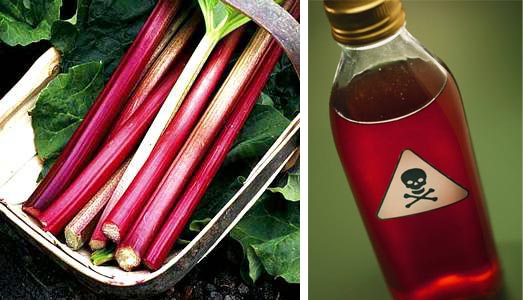
Potatoes
The potato has many practical uses in the food world, be it boiled, roasted, mashed, sautéed or made into fashionable eveningwear, the potato is a versatile part of our diet, which makes it all the more shocking that it can actually kill us.
The lethal poisons associated with potatoes actually reside in the stems, leaves and sprouts but can build up within the part of the potato we eat if left around (especially in the light) for too long, with the green tint that the potato can pick up being a giveaway that it's not good to eat.
The compounds that kill are known as glycoalkaloids and can also be found in other plants, such as deadly nightshade. Consuming glycoalkaloids can lead to diarrhea, cramps, general confusion, headaches and even a coma or death.
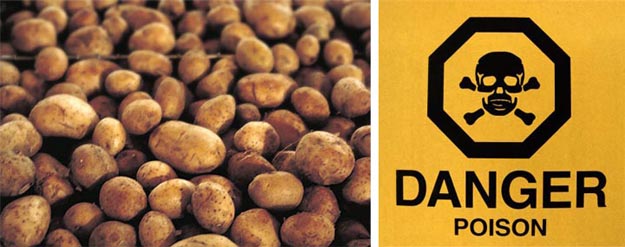
Almonds
Everyone thinks they're nuts, but they're actually technically a seed or fruit, as the "nut" part is the innermost part of a fruit (like an "embryo"), with the outer part (referred to as an exocarp) requiring removal before one can access the edible almond part. They're commonly sold shelled and have come to be known as nuts. They can also kill you.
Almonds come in a few varieties, including sweet and bitter versions. It's these bitter almonds that you have to watch out for as they contain relatively large amounts of hydrogen cyanide, an extremely poisonous and probably not-all-that-delicious substance, with a handful of these bitter almonds typically being enough to kill a person.
Bitter almonds can be made fit for human consumption, but they have to be heat-treated in order to nullify the cyanide as it's illegal in most places to sell raw bitter almonds anymore, due to the possibility of death and whatnot.

Fast Food
*Insert obligatory and "hilarious" reference to fast food being poisonous here*

Leafy Greens
Supposedly at the other end of the scale to fast food, leafy greens still have the potential to kill you and perhaps even quicker than fast food can if you're not careful, as they topped a report that looked into the top ten riskiest foods.
Such food poisoning staples as E. coli, salmonella and even Norovirus were found to be the root causes of leafy green-related illnesses, most of which could have been avoided with careful food preparation, namely actually washing the food properly before handling it. But then again, that's what you get for eating too many leafy greens. You get DEAD.
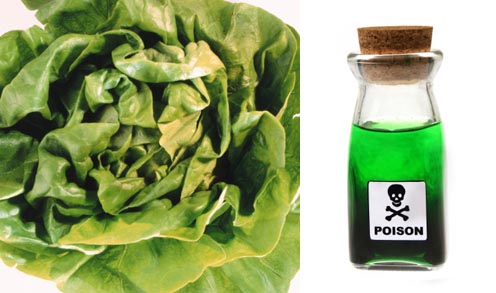
Dairy (chiefly eggs, milk and ice cream)
By now, most of us are somewhat aware that eating rotten dairy can have some pretty drastic consequences, SO STOP DOING IT. Also, we know that improperly prepared eggs can cause salmonella, so we'll just get that one out of the way, as it's milk and ice cream that you should be looking out for. But not cheese, because cheese is wonderful.
Milk - We all know that it's no fun drinking leftover milk that starting to turn into solid lumpy bits, but it can still cause a problem before it's even reached that stage, as evidenced by the Chinese milk scandal in 2008. The problem here wasn't salmonella, but melamine, a substance harmful to humans.
In order for their milk to pass inspection, the melamine was added to a wide range of products (including baby milk) so as to make them appear to have a higher protein content. Sadly, adding poison to things being eaten and drunk has never been a great idea and hundreds of thousands of people were affected directly by these contaminated milk products. Bad times.
Ice cream - Milk and eggs can also be tied into any problems that related to poisoning via ice cream (laugh, but it is possible). The Schwan ice cream company recalled an entire line of ice cream thanks to a salmonella outbreak that had been traced back to their ice cream product. It turned out that the trucks they used to transport their ice cream had not been washed properly after also having transported raw, unpasteurized eggs.
Ice cream is also high on the list of poisonings at home thanks to homemade recipes being concocted that would then go on to include unpasteurized milk, which can harbor pathogens (such as salmonella) that are potentially quite dangerous. So watch out when you're taking a bite of that delicious frozen treat, drinking that pale ambrosia or eating a raw egg, because it could kill you.
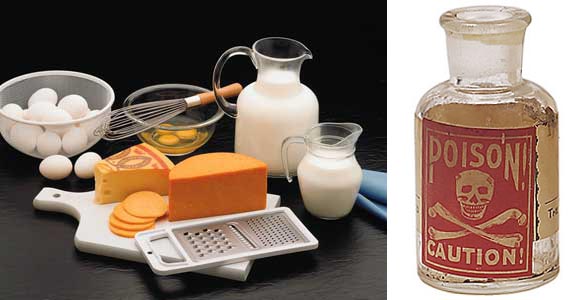
Water
They say that water is the source of all life. Well, you know what? It can also kill you. So perhaps it's more accurate to say that water is the source of all life, but also the source of a modicum amount of death.
Also known as water poisoning or hyper-hydration, water intoxication is essentially death by drinking too much water. Neither is it all that unheard of, as a couple of years ago a woman famously died during a competition to win a Wii console (as if the Wii is even worth it) in which she was required to "Hold [her] Wee For A Wii" by drinking a whole load of water and then not use the bathroom for as long as possible. Which then killed her.
The over-consumption of water causes an imbalance in electrolytes in the brain, causing either hypernatremia or hyponatremia, potentially lethal electrolyte imbalances. There have also been many other notable cases appearing over the years.
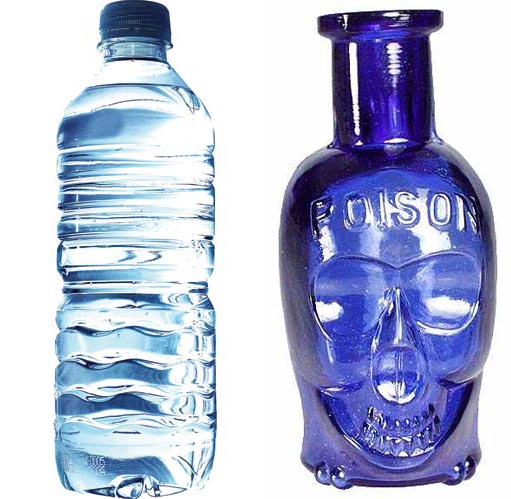
Ackee Fruit
For those of you that are adventurous eaters, we've prepared a couple of spicier - or least less-common - entrants in the list, just to keep you amused, one of which is the ackee fruit, a very popular national fruit of Jamaica.
While despite looking somewhat like a Star Wars reject and probably tasting sort of OK, picking the ackee fruit before the time is right can lead to what's known as Jamaican vomiting sickness. The fruit itself contains a toxin called hypoglycin A, which limits the body's ability to release glucose from the liver, something that is essential in keeping blood/sugar levels stable between meals. With this inhibited by the hypoglycin from the ackee fruit, a person can subsequently suffer from severe hypoglycemia, also causing vomiting, dehydration, seizures, coma and even death. All thanks to a really ugly fruit.
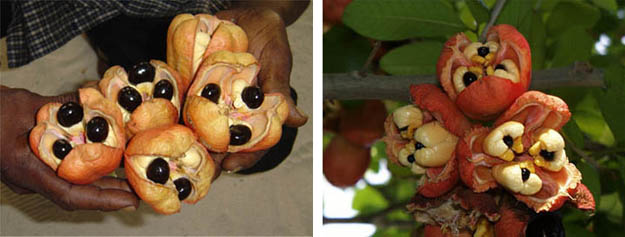
Namibian Bullfrog
While the French tend to eat just the legs, the Namibians devour the whole thing, which is slightly on the dangerous side as the frogs contain a deadly poison that can cause kidney failure (known locally as Oshiketakata) and - in more extreme cases - death.
Apparently the ideal time to consume delicious frog is "after the third rain" of the season, identified by excessive croaking and breeding on the part of the frogs. Another preventative involves lining the cooking pot with dry wood, which purportedly neutralizes the frog's poison
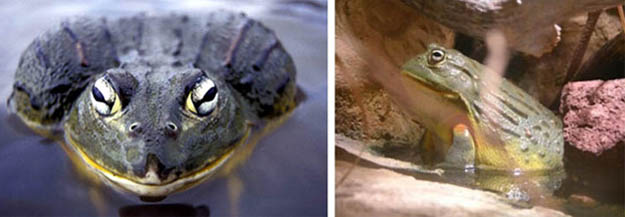
Cassava
Also called yuca, cassava is a food staple the world over, used in bread, soups, stews, as an accompaniment to meat dishes, that horrible tapioca stuff and many, many other things.
Of course, there is a downside and that's the fact that if it isn't prepared properly before consumption (or eaten raw), then it turns into wondrous hydrogen cyanide, which is quite poisonous and will kill you.
Cassava comes in two varieties, known as the "bitter" and "sweet" types, depending on how much potential death they carry within them. The "sweet" variety produces 50 times less death (around 20mg/kg of cyanide/kilogram of fresh root) but is still poisonous enough to kill a cow. Poor cow.
Even though it's common knowledge in cassava-consuming countries to make damn sure you prepare it properly, there are still dangers to be had. If the cassava is treated/processed insufficiently, then it can lead to what's known as konzo, a debilitating paralytic disease. A safe method of preparation is to mix any cassava flour (for the roots, cooking is generally all that's needed) with water, make a paste and spread it over a basket, then let said paste stand for five hours. The cyanide produced by the cassava is then broken down and released into the atmosphere, making it safe to consume.
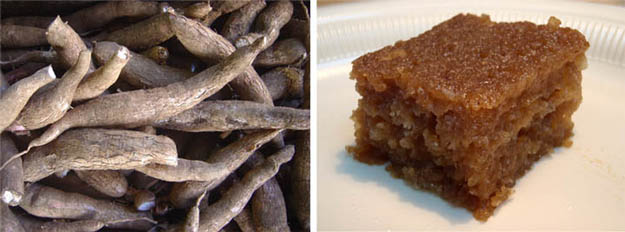
Bonus: Deep-Fried Butter
It's just as it sounds.
Butter.
Deep-fried.

Find us on Google+
